
Wine Culture and Information since 2002 - Volume 22
 Wine Culture and Information since 2002 - Volume 22 |
|
Issue 156, November 2016 |
Contents |
|
|
The Magic of Time |
|
I am going to talk again about the wonderful relationship between wine and time. Better to say, what time is capable of making to those wines made with the purpose of improving and evolving in the course of the years. A quality, traveling with time, which is not allowed to every wine as this is made only with the goal of making a wine capable of “challenging” time. It takes, first of all, a strict quality both in vineyard and in winery - and sometimes some wine making tricks as well - and the far-sighted capability of seeing the evolution of wine and grapes making it. I admit it: I have a particular passion for wines which can benefit from the caress of time, a magic that, when it is successful, is capable of giving extraordinary and unrepeatable emotions. From bubbles to fortified wines, there is no wine style I do not like when “they are aged for sometime” - those which can do that, of course - as they are also capable of giving me an extraordinary chance of sensorial study. The occasion of talking again about the connection of wine to time has also been offered by a pleasing confirmation I recently had when I uncorked two bottles being more than 10 years old. To tell the truth, it has been a special occasion going beyond the simple act of uncorking those bottles. I in fact had the pleasure - and I would add, the honor - of sharing these two bottles with the “father” of those two beautiful wines. There is more: it has also been a wish turning into reality and waiting for right time - the time of wine and of making the right occasion - in order to become true. These two wines are Bianca di Valguarnera 2005 and Duca Enrico 2003, both made by Duca di Salaparuta; the father, a competent wine maker with an extraordinary prestige: Carlo Casavecchia. Many in fact will remember the long time Carlo Casavecchia worked for this famous Sicilian winery - and Florio - in particular, for the fundamental contribution the great wine maker from Alba gave to the revaluation and the prestige of Marsala wine. I am not going to talk about the competence and huge talent of Carlo Casavecchia: his brilliant career, the many wines he made and his résumé prove, undoubtedly, his prestige. Graduated in 1982 in wine making with the highest ranking, Carlo Casavecchia has worked, among the many things, the with great Giacomo Tachis - probably the greatest Italian wine maker of all times - and with whom he personally witnessed the renaissance of Italian quality wine. Carlo Casavecchia has a wine competence and versatility I would define of encyclopedic and extraordinary skill, capable of giving life to magnificent wine masterpieces, from great bubbles to perfect fortified wines, Marsala in particular. The occasion of uncorking those bottles with Carlo Casavecchia happened - or better to say, was created - with time and, who knows, by chance. Everything started some years ago when I bought a bottle of Bianca di Valguarnera 2005 and one of Duca Enrico 2003. Those two bottles have been stored in my cellar for a long time, while I was continuously promise myself, sooner or later, I would have uncorked them.
Few years ago, while I was looking for another bottle to be uncorked for the occasion of that night, I found those two bottles and the idea immediately came to my mind. Those bottles, this was the right thing to do, would have been shared with their creator, the wine maker who - some years ago - gave them life. Not only the pleasure of sharing some bottles with a dear friend, indeed the curiosity of knowing his opinion and impression about those two prodigal sons. I left them in the cellar, with the idea - sooner or later - I would have phoned Carlo Casavecchia and tried to arrange things. The occasion finally happened at the beginning of October and it was also the chance for a beautiful journey to Langhe - just one of the many, however always exciting and new - while having as a prestigious guide the authoritative knowledge of Carlo Casavecchia. A beautiful journey passing by the famous Barolo municipalities, including a very interesting Lectio Magistralis about Nebbiolo clones, soil types and the respective characteristics they give wines. It is then the time to uncork those two bottles to which the good Carlo decided to add a couple of Barolo Piantà, produced by the family winery, vintages 2003 and 1998. The first wine to be poured in glasses was Bianca di Valguarnera 2005, produced with 100% Inzolia and aged in barrique. Eleven years for a white wine of extraordinary elegance and finesse, a crispness making you think about a quite younger wine. A powerful and rich nose, expressing remarkable cleanness with typical Inzolia aromas to which were added the aromas given both by time and the evolution of tertiary characteristics. Sumptuous and very elegant, it seemed in the glass I had a Corton-Charlemagne, giving sensations of butter, honey and vanilla as well as toasted and dried fruits. It is not by chance, in fact, the famous wine from Burgundy gives its best after about ten years. We leave Bianca di Valguarnera in its glass - in order to make it benefit from the work of oxygen even more - and we pass to Duca Enrico 2003. Also in this case, astonishing wine. One hundred percent Nero d'Avola, Duca Enrico has been one of the first wines made with this grape to give prestige to the enology of Sicily. An exclusive tasting made even more special thanks to Carlo Casavecchia's comments, with interesting remarks about grapes and vintages of Sicily, of course including anecdotes about the production of those two wines. Duca Enrico 2003, just like Bianca di Valguarnera 2005, did not show its age - thirteen years old - however rich and having an extraordinary complexity, both to the nose and mouth. Peaks of licorice, leather, tar and dark berried fruits - in particular blackberry - having a surprising freshness yet showing a good evolution. A magnificent interpretation of Nero d'Avola. Time, when you have both the right wine and interpreter, is capable of extraordinary magic. At this point, I am sure you are wondering about Barolo Piantà 2003 and 1998. Fantastic and wonderful: 2003 in magnificent shape and superb, 1998 elegant and rich, although it needed a longer time in order to properly express its quality. Two perfect companions for the two Sicilian wines I had brought with me, stupendous interpretations of the Piantà cru and made by Casavecchia winery of Diano d'Alba, rich and robust like the area of Castiglione Falletto can give. Good job, Carlo! Antonello Biancalana
|
||||||||||||
Contrasts of Dolcetto and NegroamaroThis month Piedmont and Apulia are being compared one to one in our glasses. Two important grapes in their respective lands, capable of making different however interesting wines |
|
This month, like it happened in the past, we will pour in our glasses wines produced with typical grapes of two geographically distant territories, a distance which can also be measured in terms of remarkable meteorological differences. Dolcetto and Negroamaro - these are the two grapes protagonists of this month's tasting by contrast - play primary viticoltural and enological roles in their respective lands: Piedmont and Apulia. Two different grapes also from an enological point of view, something clearly evident from the avaluation of wines produced with these varieties. The wine making style used for the production of these wines is in fact another diversity factor. Dolcetto is mainly vinified in inert tanks - steel and cement tanks - whereas Negroamaro has in cask and barrique its most common wine making practice. For the sake of truth, it should be noticed Dolcetto too can be vinified in cask, a practice however marginal and not so common. Dolcetto and Negroamaro are two of the main varieties in their respective homelands - Piedmont and Apulia - they are widely used for the production of wines both alone and blended to other grapes. The wines they make are however different and express quite diverse personalities which will be evident and clear by comparing them in a tasting by contrast. Of the two grapes, Dolcetto is the one who spread beyond its original land and today it is found, although marginally, in other areas of Italy as well. On this regard it should be said the origin of Dolcetto has been debated for a long time between Piedmont and Liguria. Even today it is in fact not clear from what region this grape is from and how it spread to the other one, although the most supported hypothesis is Dolcetto originated from Piedmont. Negroamaro is virtually found in Apulia only and it is mainly cultivated in the Salento area, used in most of the wines produced in this land.
|
|
Dolcetto is a very common variety in Piedmont, in particular in the wide territory including Monferrato, Asti and Alba. Dolcetto is so popular in this territory as to be part of countless DOC and DOCG wines of the region, including Piedmont DOC covering the whole region. In all of these territories Dolcetto expresses different personalities, however keeping its well known identity. In Liguria Dolcetto is known as Ormeasco and also in this region it is the protagonist - alone or blended to other varieties - in many DOC wines. Dolcetto is also found in other Italian regions where it is used for the production of many IGT wines (Indicazione Geografica Tipica, Typical Geographical Indication). Wines produced with Dolcetto are characterized by the strong olfactory profile recalling fruits and flowers, a quality requiring a vinification in inert container in order to keep this dominant quality. It should also be said there are Dolcetto wines vinified in cask or barrique, giving interesting results and getting a particular character. It is believed Dolcetto is a very ancient variety despite the first written mentions are relatively recent and dated back to the end of 1500s. These documents support the hypothesis Dolcetto comes from the Monferrato area, a territory where it is still today widely common and appreciated. It is likely Dolcetto was introduced to Liguria from Monferrato, in particular to the western part of the region, where it is known as Ormeasco. The origin of this name is to be found to Ormea, a village in the province of Cuneo - therefore in Piedmont - and located few miles North from Liguria and, in particular, Pornassio, in province of Imperia. In this tgerritory of Liguria Dolcetto - Ormeasco - is used for the production of table wines as well as interesting sweet and fortified style, including Sciac-trà, not to be confused with Sciacchetrà of Cinque Terre, in province of La Spezia. Piedmont is the region where Dolcetto expresses wines of different personalities, while offering a crisp and immediate character as well as more robust and complex interpretations.
|
||||
|
Negroamaro is the most common variety of Salento. This grape is found in the whole territory of Apulia, however it is in the famous area of the bottom heel of Italy where Negroamaro is mainly found and cultivated at. A fundamental grape of the most representative wines of Salento - including Salice Salentino - in this territory Negroamaro is frequently blended to Malvasia Nera, however capable of giving great wines also in case it is vinified alone. Negroamaro is also a variety widely used for the production of the well known rose wines of Salento, a style very typical in this territory and among the most significant ones of Italy. In the production of red wines, Negroamaro gives wines of remarkable prestige and it is successfully vinified both in inert containers and in cask or barrique. Because of its huge presence, although it is mainly and exclusively found in Apulia, in terms of quantity Negroamaro is one of the most cultivated varieties in Italy. The origins of Negroamaro are not clear and still today there are many hypotheses about it, including the origin of its name. The most common theory believes Negroamaro is a variety coming from Greece and introduced to Apulia, however this theory is not supported by some. Also the origin of the name is debated by many and, among the many hypotheses, the most supported one wants this name originating from the Latin niger and Greek mavro, both meaning black. Accorging to this, its name is a repetition of the word “black” because of the deep and intense color of its wines. Despite it is believed Negroamaro is a very old variety - and in past times common in Southern Italy, today mainly in Apulia - the first written mention is dated back to the end of 1800s. In documents where Negroamaro has been mentioned, it is always praised as a valuable grape, capable of making quality wines with a deep color, characteristics it still has today.
|
|
Our tasting by contrast will examine two wines respectively produced with 100% Dolcetto and Negroamaro. Choosing a Negroamaro is, like to say, more simple than Dolcetto, as its main and most significant territory is Salento. Things get more complicated in choosing Dolcetto because of the many denominations in which this Piedmontese grape is found and each of them is characterized by a distinct personality. Of the many denominations, the most famous one is Dogliani where it is produced a Dolcetto that, with Ovada and Diano d'Alba, is classified as a DOCG wine (Denominazione d'Origine Controllata e Garantita, Guaranteed and Controlled Denomination of Origin). Specifically, this classification is reserved to Dolcetto di Dogliani Superiore only, commonly known as Dogliani. In both cases we will choose wines produced in inert containers - in order to better appreciate the specific qualities of the respective varieties - and not being older than two years. Wines will be served at a temperature of 17 °C (63 °F) and poured in two tasting glasses.
After having poured the wines in their respective glasses, let's start our tasting by contrast and, as usual, we will focus on the appearance of Dolcetto and Negroamaro. This phase of the tasting, in which we will evaluate both color and transparency of the wines, will let us understand significant differences, in particular nuances. Dolcetto and Negroamaro have in fact a good coloring property and this quality is well perceptible by observing the wines. The color of Dolcetto is intense ruby red, frequently deep, and nuances - observed at the edge of the glass after having titled it - reveals a pretty intense purple red color. Transparency in Dolcetto, observed at the base of the glass, is pretty low. Let's now pass to the evaluation of Negroamaro. The color of this wine shows an intense and brilliant ruby red, with a low transparency although higher than Dolcetto. Nuances in Negroamaro, observed by tilting the glass, reveal a brilliant ruby red. The olfactory profiles of Dolcetto and Negroamaro are characterized by significant and substantial differences. On this regard it is interesting to consider the difficulty producers have when they transform Dolcetto into wine. This interesting Piedmontese variety is in fact known among producers for being quite demanding during vinification and it takes a small delay in racking to compromise the olfactory finesse of wine. It should be said neglecting the racking operation compromises the olfactory finesse of every wine, however in Dolcetto the right management of racking is both critical and fundamental. This explains the reason why Dolcetto sometimes have a quite ordinary olfactory profile and even characterized by faults. The use of cask or barrique can sometimes hide these faults, while considering that, when the use of wood is excessive, this tends to hide the typical qualities of Dolcetto as well. Let's start the evaluation of olfactory profiles from the glass of Dolcetto di Dogliani. By holding the glass in vertical position and without swirling, let's proceed with the first smell which will allow us to evaluate opening aromas. From the glass will be perceived intense aromas of cherry, plum and raspberry to which follow the pleasing aroma of violet. After having swirled the glass, in order to favor the development of wine aromas, let's proceed with a second smell. It will be perceived aromas of blueberry, strawberry, cyclamen, sometimes geranium, and - finally - a pleasing aromas of bitter almond, pretty frequent in wines produced with Dolcetto. Let's now pass to the glass of Negroamaro which will give us an olfactory profile clearly recalling dark skinned fruits. The opening of this famous variety from Salento will give aromas of plum, black cherry and blackberry to which follow violet. After having swirled the glass, the second smell will complete the profile of Negroamaro with blueberry, raspberry and cyclamen, to which follow, sometimes, the aroma of carob. Let's now pass to the gustatory evaluation of the wines of our tasting by contrast by starting from Dolcetto di Dogliani. Let's take a sip of this wine and evaluate its attack, that is the sensations produced during the first moments of gustatory perception. Dolcetto is characterized by a moderate sensation of astringency to which follow a pleasing crispness given by acidity and a good body. The wine reaches its balance thanks to the contribution of alcohol making the wine, among the other things, rounder. It will be perceived in the mouth flavors of cherry, plum and raspberry, perfectly correspondent to the nose. Let's now pass to the evaluation of Negroamaro: in the mouth will be perceived an attack of moderate astringency and, as opposed to Dolcetto, the profile is evidently rounder. In this case the sensation of crispness is weaker than Dolcetto and are perceived flavors of plum, blackberry and black cherry with a good correspondence to the nose. Negroamaro is also characterized by a good body, just like Dolcetto. The ending phase of our tasting by contrast will focus on the evaluation of the final sensations wines leave to the mouth after having swallowed them. The finish of Dolcetto di Dogliani has a good persistence and in the mouth can be perceived flavors of cherry, plum and raspberry as well as a pleasing sensation of acidity and a moderate astringency. The finish of Negroamaro leaves in the mouth a sensation of good body and a pleasing roundness well fused to a moderate astringency. In the mouth are perceived flavors of black cherry, plum and blackberry. After having evaluated the finish of both wines, let's compare their final sensations, in particular the different impact of acidity and roundness. On this regard will be perceived substantial differences, while we will notice an evident similarity in the sensations of structure and astringency.
|
||||||||
Wines of the Month |
|
|
|
Score legend Prices are to be considered as indicative. Prices may vary according to the country or the shop where wines are bought |
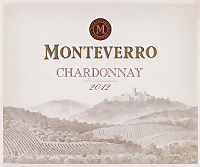
|
|
Chardonnay 2012 |
|
| Monteverro (Tuscany, Italy) | |
 Chardonnay Chardonnay | |
| Price: € 79.00 | Score: |
 Brilliant golden yellow and nuances of golden yellow, very transparent. Brilliant golden yellow and nuances of golden yellow, very transparent. Intense, clean, pleasing, refined and elegant, starts with hints of
banana, citron and plum followed by aromas of honeysuckle, honey, apple,
hawthorn, pear, hazelnut, grapefruit, toasted bread and vanilla. Intense, clean, pleasing, refined and elegant, starts with hints of
banana, citron and plum followed by aromas of honeysuckle, honey, apple,
hawthorn, pear, hazelnut, grapefruit, toasted bread and vanilla.
 Crisp attack and however balanced by alcohol, full body, intense
flavors, pleasing roundness. Crisp attack and however balanced by alcohol, full body, intense
flavors, pleasing roundness.
 Persistent finish with flavors of banana, citron and honey. Persistent finish with flavors of banana, citron and honey. 14 months in barrique and cement tanks. 14 months in barrique and cement tanks. |
|
 Stuffed pasta, Roasted white meat, Roasted fish Stuffed pasta, Roasted white meat, Roasted fish |
|
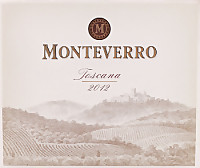
|
|
Monteverro 2012 |
|
| Monteverro (Tuscany, Italy) | |
 Cabernet Sauvignon (35%), Cabernet Franc (35%), Merlot (25%), Petit Verdot (5%) Cabernet Sauvignon (35%), Cabernet Franc (35%), Merlot (25%), Petit Verdot (5%) | |
| Price: € 110.00 | Score: |
 Intense ruby red and nuances of garnet red, little transparency. Intense ruby red and nuances of garnet red, little transparency. Intense, clean, pleasing, refined and elegant, starts with hints of
black currant, black cherry and plum followed by aromas of blueberry,
violet, iris, vanilla, face powder, chocolate, blackberry, tobacco,
licorice, mace, cigar box and eucalyptus. Intense, clean, pleasing, refined and elegant, starts with hints of
black currant, black cherry and plum followed by aromas of blueberry,
violet, iris, vanilla, face powder, chocolate, blackberry, tobacco,
licorice, mace, cigar box and eucalyptus.
 Tannic attack and however balanced by alcohol, full body, intense
flavors, pleasing roundness. Tannic attack and however balanced by alcohol, full body, intense
flavors, pleasing roundness.
 Very persistent finish with long flavors of black currant, black cherry
and blueberry. Very persistent finish with long flavors of black currant, black cherry
and blueberry.
 24 months in barrique. 24 months in barrique. |
|
 Game, Roasted meat, Broiled meat and barbecue, Stewed and braised meat, Hard cheese Game, Roasted meat, Broiled meat and barbecue, Stewed and braised meat, Hard cheese |
|

|
|
Marsala Vergine Riserva 2000 |
|
| Carlo Pellegrino (Sicily, Italy) | |
 Grillo, Catarratto, Inzolia Grillo, Catarratto, Inzolia | |
| Price: € 20.00 | Score: |
 Intense amber yellow and nuances of amber yellow, transparent. Intense amber yellow and nuances of amber yellow, transparent. Intense, clean, pleasing and refined, starts with hints of dried fig,
raisin and caramel followed by aromas of rancho, dried apricot, vanilla,
leather, candied fruits, licorice and nail polish. Intense, clean, pleasing and refined, starts with hints of dried fig,
raisin and caramel followed by aromas of rancho, dried apricot, vanilla,
leather, candied fruits, licorice and nail polish.
 Alcoholic attack and pleasing crispness, intense flavors, pleasing
roundness. Alcoholic attack and pleasing crispness, intense flavors, pleasing
roundness.
 Persistent finish with flavors of dried fig, raisin and caramel. Persistent finish with flavors of dried fig, raisin and caramel. More than 10 years in cask. More than 10 years in cask. |
|
 Hard and piquant cheese, Almond tarts Hard and piquant cheese, Almond tarts |
|
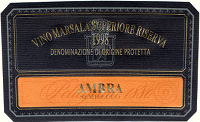
|
|
Marsala Superiore Riserva Ambra Semisecco 1998 |
|
| Carlo Pellegrino (Sicily, Italy) | |
 Grillo, Catarratto, Inzolia Grillo, Catarratto, Inzolia | |
| Price: € 18.00 | Score: |
 Deep amber yellow and nuances of amber yellow, moderate transparency. Deep amber yellow and nuances of amber yellow, moderate transparency. Intense, clean, pleasing and refined, starts with hints of dried fig,
leather and caramel followed by aromas of rancho, vanilla, citrus fruit
peel, almond, date, honey and nail polish. Intense, clean, pleasing and refined, starts with hints of dried fig,
leather and caramel followed by aromas of rancho, vanilla, citrus fruit
peel, almond, date, honey and nail polish.
 Alcoholic attack and pleasing sweetness, intense flavors, pleasing
roundness and crispness. Alcoholic attack and pleasing sweetness, intense flavors, pleasing
roundness and crispness.
 Persistent finish with flavors of dried fig, caramel and honey. Persistent finish with flavors of dried fig, caramel and honey. More than 15 years in cask. More than 15 years in cask. |
|
 Confectionery, Dried fruit tarts, Hard cheese Confectionery, Dried fruit tarts, Hard cheese |
|

|
|
Ales 2012 |
|
| L'Arco Antico (Molise, Italy) | |
 Montepulciano Montepulciano | |
| Price: € 9.00 | Score: |
 Intense ruby red and nuances of ruby red, little transparency. Intense ruby red and nuances of ruby red, little transparency. Intense, clean, pleasing and refined, starts with hints of black
cherry, plum and dried violet followed by aromas of blackberry, vanilla,
chocolate, tobacco and menthol. Intense, clean, pleasing and refined, starts with hints of black
cherry, plum and dried violet followed by aromas of blackberry, vanilla,
chocolate, tobacco and menthol.
 Properly tannic attack and however balanced by alcohol, good body,
intense flavors, agreeable. Properly tannic attack and however balanced by alcohol, good body,
intense flavors, agreeable.
 Persistent finish with flavors of black cherry, plum and blackberry. Persistent finish with flavors of black cherry, plum and blackberry. 12 months in barrique. 12 months in barrique. |
|
 Pasta with meat, Roasted meat, Broiled meat and barbecue, Stewed meat with mushrooms Pasta with meat, Roasted meat, Broiled meat and barbecue, Stewed meat with mushrooms |
|
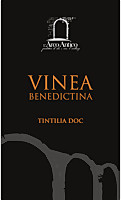
|
|
Molise Tintilia Vinea Benedictina 2014 |
|
| L'Arco Antico (Molise, Italy) | |
 Tintilia Tintilia | |
| Price: € 17.10 | Score: |
 Deep ruby red and nuances of ruby red, little transparency. Deep ruby red and nuances of ruby red, little transparency. Intense, clean, pleasing and refined, starts with hints of black
cherry, plum and blueberry followed by aromas of blackberry, black currant,
violet, carob and vanilla. Intense, clean, pleasing and refined, starts with hints of black
cherry, plum and blueberry followed by aromas of blackberry, black currant,
violet, carob and vanilla.
 Tannic attack and however balanced by alcohol, good body, intense
flavors, agreeable. Tannic attack and however balanced by alcohol, good body, intense
flavors, agreeable.
 Persistent finish with flavors of black cherry, plum and blackberry. Persistent finish with flavors of black cherry, plum and blackberry. 12 months in barrique. 12 months in barrique. |
|
 Roasted meat, Stewed meat with mushrooms, Broiled meat and barbecue, Cheese Roasted meat, Stewed meat with mushrooms, Broiled meat and barbecue, Cheese |
|
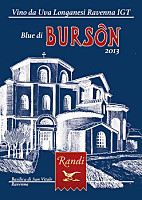
|
|
Blu di Bursôn 2013 |
|
| Randi (Emilia Romagna, Italy) | |
 Longanesi Longanesi | |
| Price: € 12.00 | Score: |
 Intense ruby red and nuances of ruby red, little transparency. Intense ruby red and nuances of ruby red, little transparency. Intense, clean, pleasing and refined, starts with hints of black
cherry, blackberry and raspberry followed by aromas of violet, plum,
green bean, hay, blueberry, carob and menthol. Intense, clean, pleasing and refined, starts with hints of black
cherry, blackberry and raspberry followed by aromas of violet, plum,
green bean, hay, blueberry, carob and menthol.
 Properly tannic attack and however balanced by alcohol, good body,
intense flavors, pleasing crispness. Properly tannic attack and however balanced by alcohol, good body,
intense flavors, pleasing crispness.
 Persistent finish with hints of black cherry, blackberry and raspberry. Persistent finish with hints of black cherry, blackberry and raspberry. 12 months in steel tanks. 12 months in steel tanks. |
|
 Pasta with meat and mushrooms, Broiled meat and barbecue, Roasted meat, Stewed meat with mushrooms Pasta with meat and mushrooms, Broiled meat and barbecue, Roasted meat, Stewed meat with mushrooms |
|
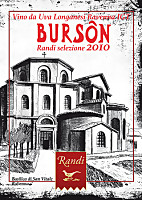
|
|
Bursôn Selezione 2010 |
|
| Randi (Emilia Romagna, Italy) | |
 Longanesi Longanesi | |
| Price: € 15.00 | Score: |
 Deep ruby red and nuances of garnet red, little transparency. Deep ruby red and nuances of garnet red, little transparency. Intense, clean, pleasing and refined, starts with hints of plum, black
cherry and raspberry followed by aromas of dried violet, green bean, black
currant, hay, chocolate, licorice, vanilla and menthol. Intense, clean, pleasing and refined, starts with hints of plum, black
cherry and raspberry followed by aromas of dried violet, green bean, black
currant, hay, chocolate, licorice, vanilla and menthol.
 Tannic attack and however balanced by alcohol, full body, intense
flavors, pleasing crispness. Tannic attack and however balanced by alcohol, full body, intense
flavors, pleasing crispness.
 Persistent finish with flavors of plum, black cherry and raspberry. Persistent finish with flavors of plum, black cherry and raspberry. Part of the grapes are dried, 24 months in cask, at least 12 months in
bottle. Part of the grapes are dried, 24 months in cask, at least 12 months in
bottle.
|
|
 Game, Roasted meat, Stewed and braised meat, Hard cheese Game, Roasted meat, Stewed and braised meat, Hard cheese |
|
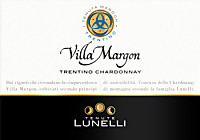
|
|
Trentino Chardonnay Villa Margon 2014 |
|
| Lunelli (Trentino, Italy) | |
 Chardonnay (85%), Pinot Bianco, Sauvignon Blanc, Incrocio Manzoni (15%) Chardonnay (85%), Pinot Bianco, Sauvignon Blanc, Incrocio Manzoni (15%) | |
| Price: € 14.00 | Score: |
 Brilliant straw yellow and nuances of greenish yellow, transparent. Brilliant straw yellow and nuances of greenish yellow, transparent. Intense, clean, pleasing and refined, starts with hints of banana,
apple and acacia followed by aromas of pear, hawthorn, grapefruit, plum,
citrus fruits, mineral and hints of vanilla. Intense, clean, pleasing and refined, starts with hints of banana,
apple and acacia followed by aromas of pear, hawthorn, grapefruit, plum,
citrus fruits, mineral and hints of vanilla.
 Crisp attack and however balanced by alcohol, good body, intense
flavors, pleasing roundness. Crisp attack and however balanced by alcohol, good body, intense
flavors, pleasing roundness.
 Persistent finish with flavors of apple, banana and pear. Persistent finish with flavors of apple, banana and pear. A small part of this wine ages in cask. A small part of this wine ages in cask. |
|
 Mushroom soups, Stuffed pasta, Roasted fish, Roasted white meat Mushroom soups, Stuffed pasta, Roasted fish, Roasted white meat |
|
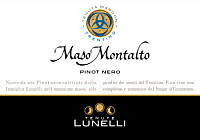
|
|
Trentino Pinot Nero Maso Montalto 2013 |
|
| Lunelli (Trentino, Italy) | |
 Pinot Nero Pinot Nero | |
| Price: € 26.00 | Score: |
 Brilliant ruby red and nuances of garnet red, moderate transparency. Brilliant ruby red and nuances of garnet red, moderate transparency. Intense, clean, pleasing and refined, starts with hints of cherry,
raspberry and blueberry followed by aromas of plum, cyclamen, pink pepper,
vanilla, tobacco, mace and menthol. Intense, clean, pleasing and refined, starts with hints of cherry,
raspberry and blueberry followed by aromas of plum, cyclamen, pink pepper,
vanilla, tobacco, mace and menthol.
 Properly tannic attack and pleasing crispness, however balanced by
alcohol, good body, intense flavors, agreeable. Properly tannic attack and pleasing crispness, however balanced by
alcohol, good body, intense flavors, agreeable.
 Persistent finish with flavors of cherry, raspberry and blueberry. Persistent finish with flavors of cherry, raspberry and blueberry. 12 months in cask, 15 months in bottle. 12 months in cask, 15 months in bottle. |
|
 Stuffed pasta, Stewed meat with mushrooms, Legume soups, Roasted meat Stuffed pasta, Stewed meat with mushrooms, Legume soups, Roasted meat |
|

|
|
Noto Nero d'Avola Santa Cecilia 2011 |
|
| Planeta (Sicily, Italy) | |
 Nero d'Avola Nero d'Avola | |
| Price: € 21.40 | Score: |
 Intense ruby red and nuances of garnet red, moderate transparency. Intense ruby red and nuances of garnet red, moderate transparency. Intense, clean, pleasing and refined, starts with hints of blackberry,
plum and black cherry followed by aromas of dried violet, blueberry, carob,
vanilla, cardamom, cocoa, tobacco and mace. Intense, clean, pleasing and refined, starts with hints of blackberry,
plum and black cherry followed by aromas of dried violet, blueberry, carob,
vanilla, cardamom, cocoa, tobacco and mace.
 Properly tannic attack and however balanced by alcohol, good body,
intense flavors, agreeable. Properly tannic attack and however balanced by alcohol, good body,
intense flavors, agreeable.
 Persistent finish with flavors of blackberry, plum and black cherry. Persistent finish with flavors of blackberry, plum and black cherry. 14 months in barrique. 14 months in barrique. |
|
 Roasted meat, Broiled meat and barbecue, Stewed meat with mushrooms, Cheese Roasted meat, Broiled meat and barbecue, Stewed meat with mushrooms, Cheese |
|

|
|
Menfi Chardonnay 2014 |
|
| Planeta (Sicily, Italy) | |
 Chardonnay Chardonnay | |
| Price: € 19.50 | Score: |
 Brilliant golden yellow and nuances of straw yellow, very transparent. Brilliant golden yellow and nuances of straw yellow, very transparent. Intense, clean, pleasing, refined and elegant, starts with hints of
banana, plum and hawthorn followed by aromas of apple, butter, acacia,
hawthorn, citrus fruits, croissant, melon, hazelnut, peach, honey and
vanilla. Intense, clean, pleasing, refined and elegant, starts with hints of
banana, plum and hawthorn followed by aromas of apple, butter, acacia,
hawthorn, citrus fruits, croissant, melon, hazelnut, peach, honey and
vanilla.
 Crisp attack and however balanced by alcohol, full body, intense
flavors, pleasing roundness. Crisp attack and however balanced by alcohol, full body, intense
flavors, pleasing roundness.
 Very persistent finish with long flavors of banana, apple and peach. Very persistent finish with long flavors of banana, apple and peach. Fermented and aged in barrique for 11 months. Fermented and aged in barrique for 11 months. |
|
 Stuffed pasta, Roasted white meat, Roasted fish, Mushroom soups Stuffed pasta, Roasted white meat, Roasted fish, Mushroom soups |
|
News |
|
In this section are published news and information about events concerning the world of wine and food. Whoever is interested in publishing this kind of information can send us a mail to our address.
|
AquavitaeReview of Grappa, Distillates and Brandy |
|
|
||||||||||||||
Wine Guide ParadeSummer 2016
|
| |||||||
Privacy Policy | |||||||


| Copyright © 2002-2024 Antonello Biancalana, DiWineTaste - All rights reserved |
| All rights reserved under international copyright conventions. No part of this publication and of this WEB site may be
reproduced or utilized in any form or by any means, electronic or mechanical, without permission in writing from DiWineTaste. |